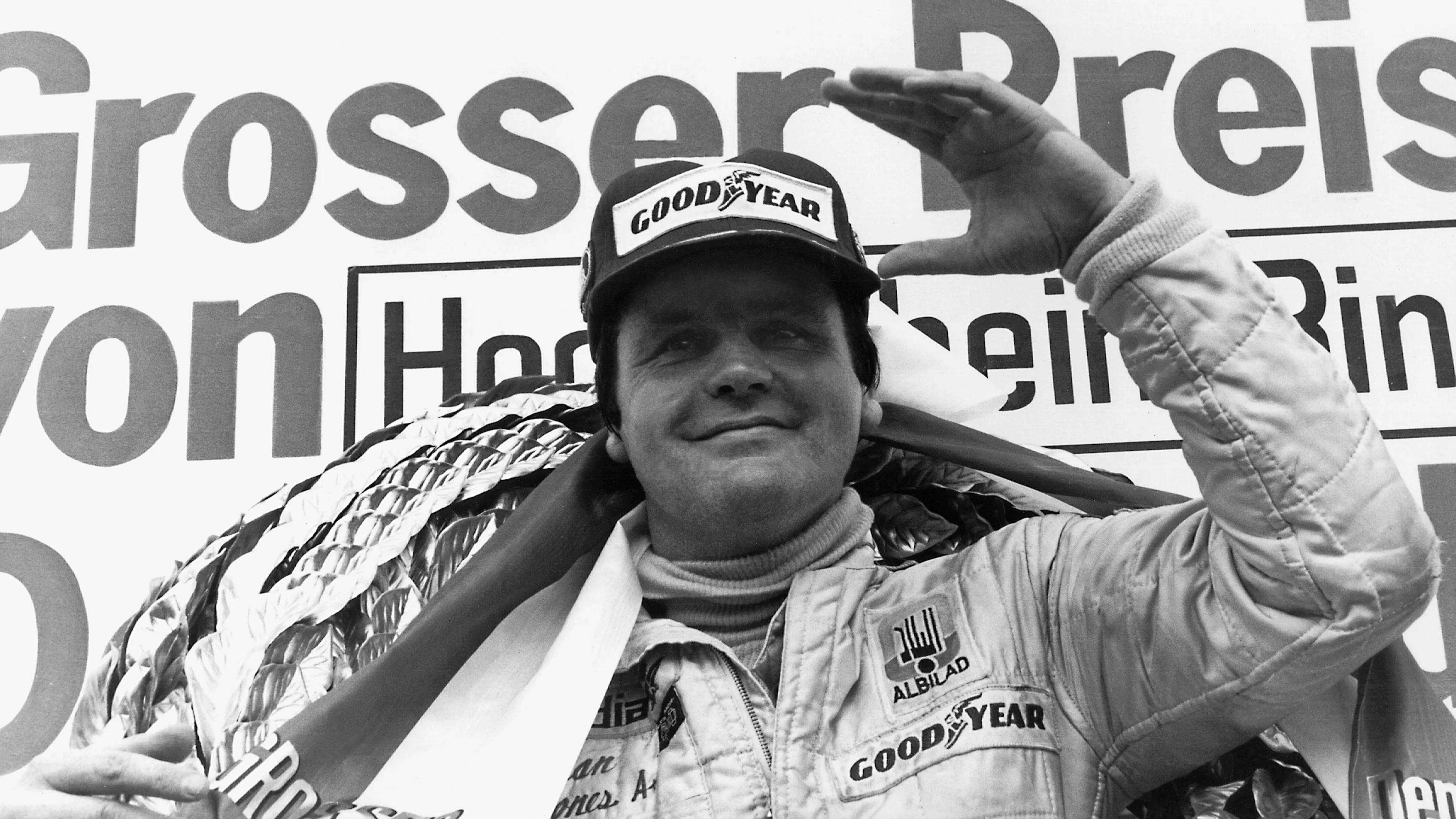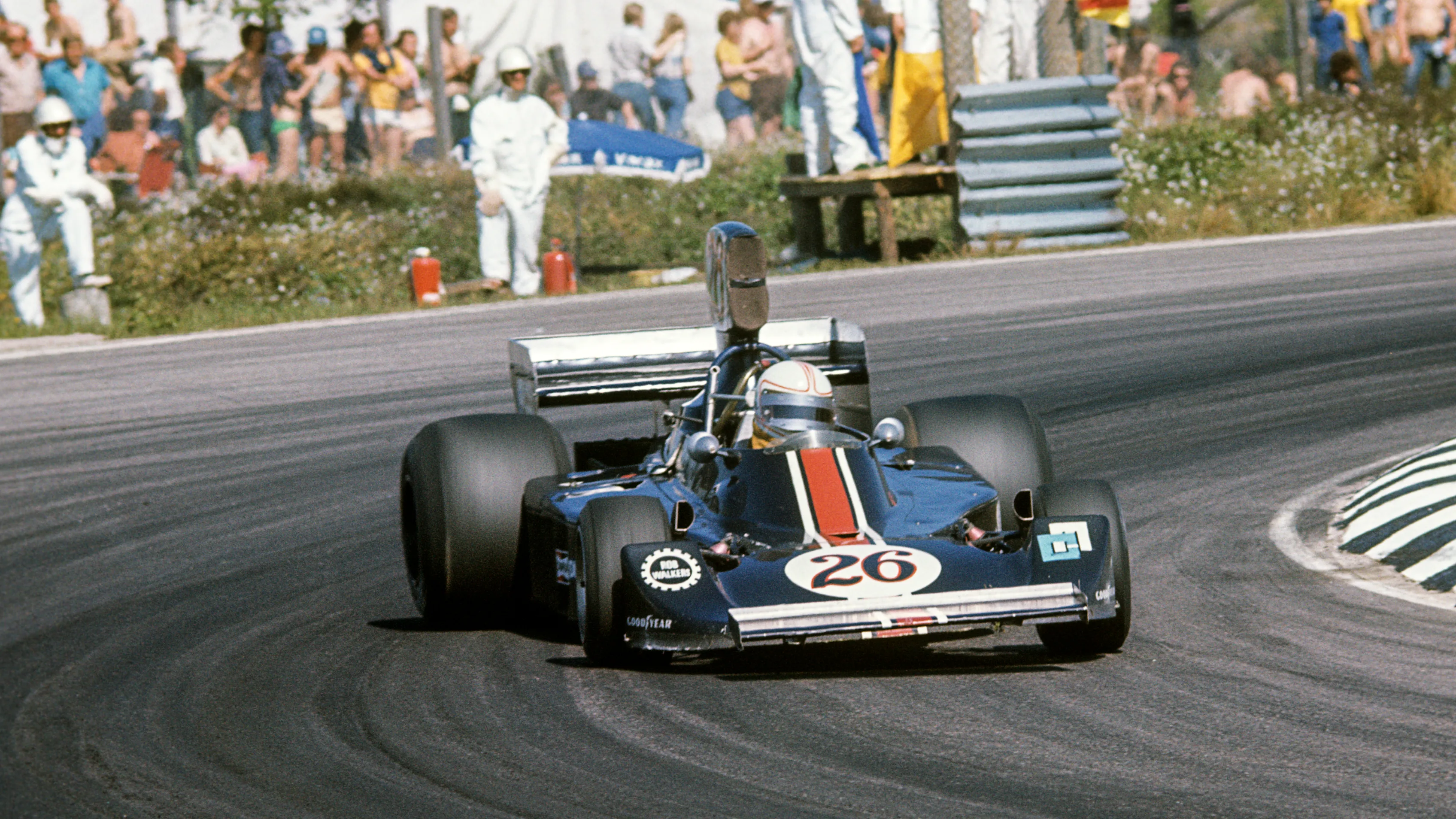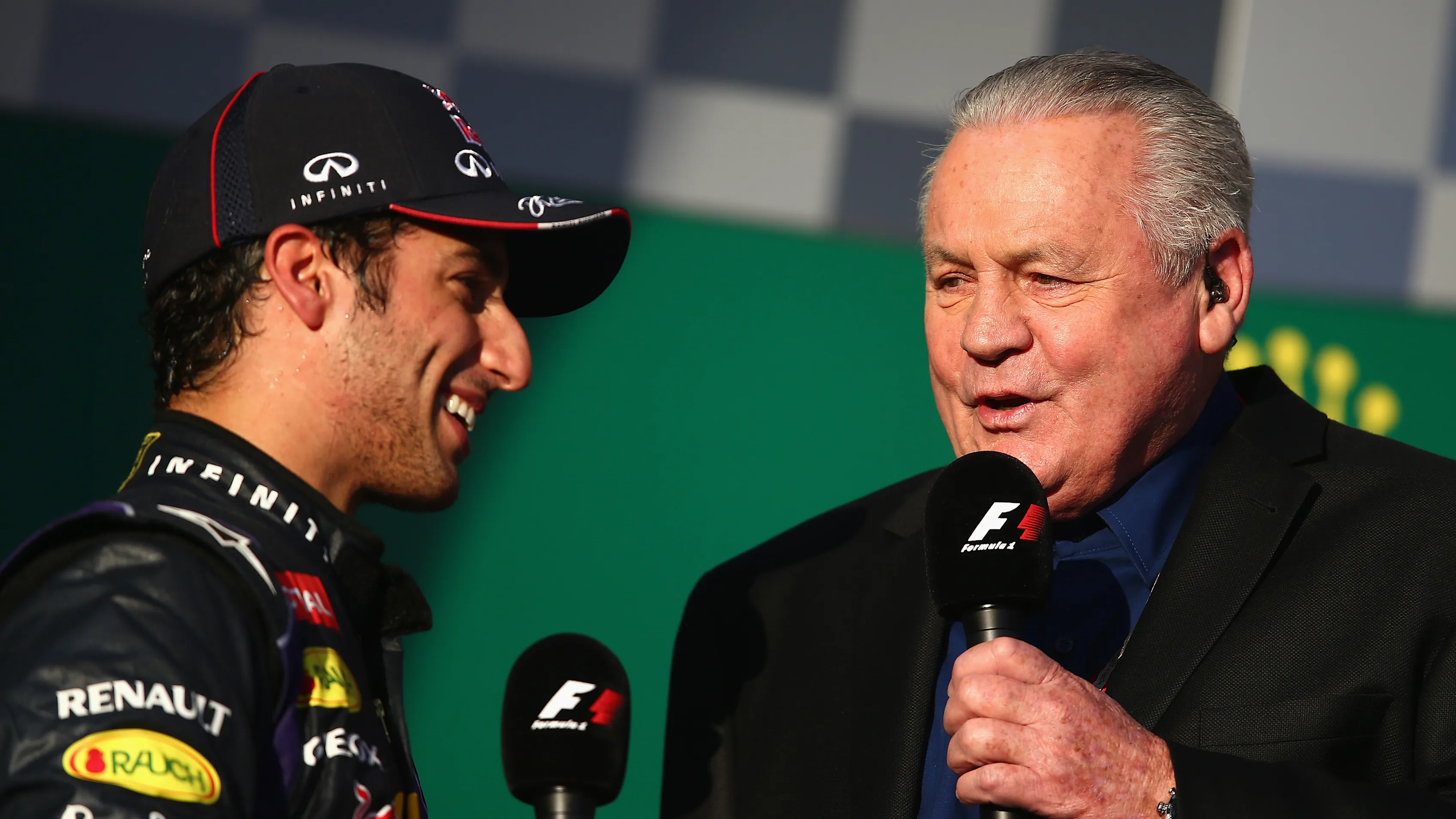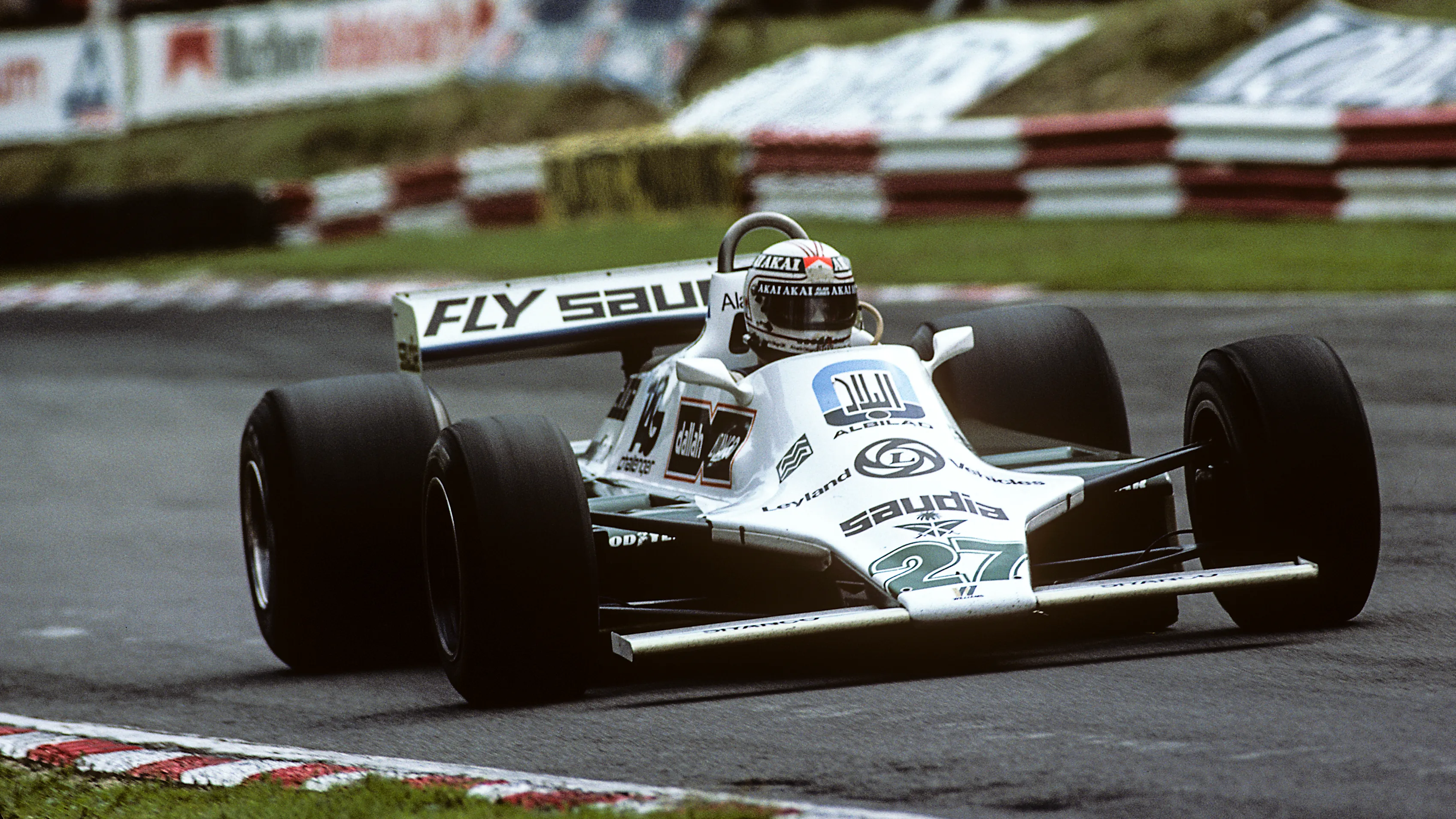HALL OF FAME - 1980
Alan Jones

A straight-talking, iron-willed, hard-driving tough guy, Alan Jones fought his way to the forefront, where he defended his territory with ruthless determination and large doses of intimidation. His belligerence was partly a by-product of a long and hard struggle to make it to Formula 1 racing in the first place. Once there, he was considered little more than a journeyman driver, until he teamed up with the then equally undistinguished Williams team. Together, they took on the world and beat it, with AJ becoming the prototypical Williams driver.
His father Stan Jones, an affluent car dealer, was one of Australia's top racers who in the mid-1950s was good enough to be offered tryouts in Europe (with BRM and Ferrari) but declined them in order to stay home and look after his business and his family. Alan Stanley Jones, born in Melbourne on November 2, 1946, was inspired by his father's successes and encouraged by him to have a go himself. At 15 he was a kart racing champion and soon also went well in a Mini and in one of his father's single-seater Coopers. Further progress was delayed when Stan Jones went bankrupt in an Australian economic recession. In 1967 Alan managed to scrape together enough cash to finance a traditional Australian tour of England and Europe. During this trip he decided that any future in motorsport would have to be pursued abroad.

In 1970, with 50 pounds in his pocket, he arrived in London and started a business to serve the needs of fellow Antipodean travellers, selling them well-used minivans. When Alan's girlfriend Bev (whom he later married) joined him in London they rented a boarding house and hired out rooms. With the meagre profits from these enterprises Alan went racing on a shoestring budget. Stan Jones, now divorced, came over to England to provide moral support, much-needed in light of his son's painfully slow progress. Alan failed to make much headway in a battered old Formula Ford then crashed a Formula Three Lotus at Brands Hatch and broke his leg. Finally, a lucky break came in the form of a sponsored F3 ride in a GRD, in which Alan scored a first victory at Silverstone in 1973. Sadly, just before this race Stan Jones died of a heart attack (at 51) and when his coffin was shipped back to Australia it contained the laurel wreath placed there by his distraught son who went on to finish second in the 1973 British F3 championship.
The next year Alan did well enough in Formula Atlantic for a private entrant to upgrade him to Formula 1 in a Hesketh for 1975. He finished that season with Graham Hill's team, scoring a solid fifth at the Nurburgring that convinced John Surtees to employ him for 1976. They didn't get along, nor did the Surtees cars go well and Alan's Formula 1 career seemed at least stalled, if not over, until a tragedy gave him another opportunity.

In the 1977 South African Grand Prix poor Tom Pryce was killed in a Shadow and the team hired Jones to replace him. Later that season a plucky drive in wet/dry conditions in Austria resulted in a maiden win for both Jones and Shadow. The team never won again but Alan's albeit somewhat fortuitous victory led to an offer of a Ferrari drive for 1978. When Ferrari reneged, and hired Gilles Villeneuve instead, Jones visited Williams Grand Prix Engineering, which to this point had gone relatively nowhere with a shortage of funds and a succession of journeyman drivers. But Jones was impressed by Frank Williams' ambition and by Patrick Head's neat and tidy Williams FW06 car and the team principals liked what they saw in 'AJ' as they called him. A deal was done and steady progress was made, with AJ winning four races and finishing third in the 1979 championship.
In 1980 the Williams FW07B and AJ was the combination to beat and, with victories in Argentina, France, Britain, Canada and the USA Alan Jones became World Champion. For the elated team boss his first title-winner became the prototypical Williams driver. "AJ was a man's man," Frank Williams said. "And he was great fun to be with. He never needed propping up mentally, because he was a very determined and bullish character. He didn't need any babysitting or hand-holding and that's the way it should be. It shouldn't be necessary for me to ask a driver if he is happy, or if he needs his underwear changed."
He wore red underpants for good luck but the blunt, burly and brave Aussie won races not by good fortune but by forceful fighting. Patrick Head admired the fact that he was "such a hard, competitive, animal in a racing car," and so he could be out of it. He once finished second in a race despite having to drive with a hand broken in a one-sided brawl with four large adversaries in London. Alain Prost, a rookie in AJ's championship year, called Jones "the most fiery, powerful - even violent - driver."
As a boy AJ described himself as "an obnoxious little bastard, a big-headed little prick." As an adult the rough edges remained and he was determinedly politically incorrect. Distrustful of foreigners, he called the French "frogs." Vehemently opposed to the women's liberation movement, he admitted that he easily qualified as a male chauvinist pig.

His season as reigning champion was waylaid by a series of mechanical problems, and though he still managed two wins and finished third in the standings, AJ decided to pack it all in and return to the "best country in the world" and become a farmer. But riding a tractor proved no substitute for racing a Formula 1 car and he soon became bored. Even falling off a horse and breaking his thigh proved to be no handicap to accepting an offer for a one-off ride with Arrows in the 1983 US Grand Prix West. However, his injury coupled with his being out of shape ("too many barbies and Fosters Lager") meant AJ performed indifferently. A more substantial comeback opportunity came in 1985, when he accepted a big money offer to join a new Beatrice Formula 1 entry. But the team started slowly, then tapered off and disappeared completely at the end of 1986.
Back home Down Under AJ raced saloon cars, helped his son Christian embark on a driving career and worked as a TV commentator on the sport in which he was once on top of the world. And in 2010 he returned to the F1 paddock in an official capacity, as an FIA stewards' advisor at selected Grands Prix.
Text - Gerald Donaldson